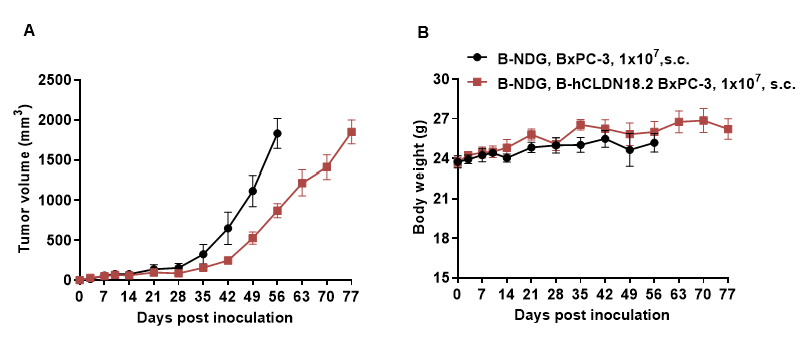Basic Information
Description
The exogenous promoter and human CLDN18.2 coding sequence were inserted into the BxPC-3 cells genome randomly. Human CLDN18.2 is highly expressed on the surface of B-hCLDN18.2 BxPC-3 cells.
-
Targeting strategy

-
Gene targeting strategy for B-hCLDN18.2 BxPC-3 cells. The exogenous promoter and human CLDN18.2 coding sequence were inserted into the BxPC-3 cells genome randomly.
-
Protein Expression Analysis

-

CLDN18.2 expression analysis in B-hCLDN18.2 BxPC-3 cells by flow cytometry. Single cell suspensions from B-hCLDN18.2 BxPC-3 cultures were stained with species-specific anti-CLDN18.2 antibody. Human CLDN18.2 was detected on the surface of B-hCLDN18.2 BxPC-3 cells. The 1-A04 clone of B-hCLDN18.2 BxPC-3 cells was used for in vivo experiments.
-
Tumor growth curve & Body weight changes

-

Subcutaneous homograft tumor growth of B-hCLDN18.2 BxPC-3 cells. B-hCLDN18.2 BxPC-3 cells (1×107) and wild-type BxPC-3 cells (1×107) were subcutaneously implanted into B-NDG mice (female, 9-week-old, n=5). Tumor volume and body weight were measured twice a week. (A) Average tumor volume ± SEM. (B) Body weight (Mean± SEM). Volume was expressed in mm3 using the formula: V=0.5 X long diameter X short diameter2. As shown in panel A, B-hCLDN18.2 BxPC-3 cells were able to establish tumors in vivo and can be used for efficacy studies.
-
Protein expression analysis of tumor cells

-

B-hCLDN18.2 BxPC-3 cells were subcutaneously transplanted into B-NDG mice (n=5), and on 77 days post inoculation, tumor cells were harvested and assessed for human CLDN18.2 expression by flow cytometry. As shown, human CLDN18.2 was highly expressed on the surface of tumor cells. Therefore, B-hCLDN18.2 BxPC-3 cells can be used for in vivo efficacy studies of novel CLDN18.2 therapeutics.
-
In vivo efficacy of anti-human CLDN18.2 antibody

-

Antitumor activity of anti-human CLDN18.2 antibody in B-hCD16A mice (CB-17 SCID) bearing B-hCLDN18.2 BxPC-3 cells. (A) Anti-hCLDN18.2 antibody inhibited tumor growth. B-hCLDN18.2 BxPC-3 cells were subcutaneously implanted into homozygous B-hCD16A mice (CB-17 SCID) (female, 10 week-old, n=6). Mice were grouped when tumor volume reached approximately 100 mm3, at which time they were treated with antibodies. (B) Body weight changes during treatment. As shown in panel, anti-hCLDN18.2 antibody was efficacious, demonstrating that BxPC3-hCLDN18.2 cells can be used to establish tumor model and provide a powerful preclinical model for in vivo evaluation of anti-hCLDN18.2 antibodies. Values are expressed as mean ± SEM.

Antitumor activity of IMAB362 in BALB/c nude mice bearing B-hCLDN18.2 BxPC-3 cells. (A) Anti hCLDN18.2 antibody slightly inhibited BxPC3-hCLDN18.2 tumor growth in BALB/c nude mice. B-hCLDN18.2 BxPC-3 cells (1×107) with Matrigel (1:1) were subcutaneously implanted into BALB/c nude mice (female, 7 week-old, n=6). Mice were grouped when tumor volume reached approximately 70 mm3, at which time they were treated with IMAB362. (B) Body weight changes during treatment. As shown, anti-hCLDN18.2 antibody was efficacious, demonstrating that BxPC3-hCLDN18.2 cells can be used to establish tumor model and provide a powerful preclinical model for in vivo evaluation of anti-hCLDN18.2 antibodies. Values are expressed as mean ± SEM.


